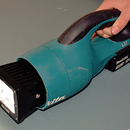Introduction: Graffiti Stencil Clock or Signs
After seeing a documentary on the TV about graffiti in Melbourne, I was amazed at the amount of work kids put into making stencils and the skill required to apply the art work to a wall or to the side of a train. They have to work quickly and risk getting arrested, (nothing like working under pressure) and are been labeled criminals and vandals. To add insult to injury the Melbourne city council will likely prosecute them, then use their art work to promote the city.
This is a way to make a graffiti style clock or sign using a laser cutter, spray paint, and some clear acrylic. The technique is quite a bit simpler than they way stencil graffiti on a wall is done, but it still quite a challenge to get all the layers the correct colors and looking right.
Step 1: Learning Intentions and Success Criteria
Learning Intentions
- To work safely in the workshop
- To improve my understanding of how the CAD software works
- To operate a laser cutter.
- To be a self-directed learner
Success Criteria
- I understand the safety rules and I am working safely in the workshop.
- I can follow the instructions independently.
- I can produce 2D CAD drawings and convert them to DXF files.
- I can operate a laser cutter.
- I can repair the project for paint and use spray paint responsibly
- I can work safely and work safely in the workshop.
Step 2: Stuff You Will Need
- A few different colored spray paints
- A CAD program that will let you trace and image
- A laser cuter
- clock motor
You wont need much for this project, but it does take quite a bit longer than you would expect.
Step 3: Choosing an Image
You want to choose a simple image one with only a few colors, many of these speed shop signs are perfect.
Also use the google tool to filter out the smaller images that will likely pixelate when enlarged. After a bit of looking around I choose the Bare Bones sign because its round and has the look Im going for.
Step 4: Preparing the Image
You need to do a few things to the image so its in the right format for the laser cutter.
- It needs to be turned into a line drawing.
- It needs to be the correct size.
- It will need to be mirrored
- If your making a clock it needs a 8mm hole for the clock motor to bolt to
- It may also need a clear boarder, for the laser to cut material to size.
- And it needs to be save as a DXF file.
There are many free programs that can do this (inkscape for example) But I'm going to use Vcarve.
If you click on the images you will find notes on what to do for this step. You may be easier to mirror the image before you start rather that flip the image in Vcarve as shown in this step.
Step 5: Setting Up the Laser Cutter
The acrylic must have a protective film on it so don't remove this. Cut the acrylic to the size of you laser cutter, and place in the machine.
The idea is to speed up the machine and reduce the power so it only cuts through the protective film. On the second cut we only want the machine to cut the outside shape of the clock and the hole in the middle.
You will need to change the speed and power settings and the cut order. The screen shots have notes and will show you how to do this.
Step 6: Painting the First Colour
Painting the first color it very easy, compare your laser cut clock to the color image and start removing the protective film on all the black parts.
Take a bit of care as you cannot put the film back if you accidentally remove the wrong part, once you think your got it right double check and check again before you start painting. It easy to miss those little bits inside letters!
Give it two or three light coats and paint and wait for it to dry. Its worth holing the clock up to the light to see if the paint is thick enough. You can see the light spilling through if the paint is too thin.
Step 7: The Second Colour
This is where the project become a little more challenging. It can be quite confusing as to which bits you have to peal of next. So refer back to your original art work and take a bit of time, to make sure its right before picking off each piece of film. Once your happy, paint the next color.
Step 8: Paint Effects
By now your probably getting the hang of this, but the more colors and detail you have on you drawing the more confusing and difficult it is to work out which bits have to be removed.
You can also try different effects with the spray paint. If you look at the teeth and bones, I wanted them to look a a bit dirty. So by giving the area a very light coat (more like over spray) with a different color you can get some shading or grading. The bones has a tiny amount of black sprayed on first, then white. The teeth were sprayed with a tiny amount of yellow then white on top. I put too much yellow on the teeth, so it didn't come out how I wanted. So the key to this is put on the a little tiny amount of paint, when you think "thats not enough", stop it is enough
Step 9: Finishing Off
So this is where the magic happens, removing the protective film reveals an unbelievably shiny finish. So shiny its hard to take photos with out reflections everywhere. All the remains to do is to fit the clock motor, and carefully push on the hands.
The clock motor never came with a hanger so I cut one out with the laser cutter and used double sided tape to stick it on.
There is only one problem, the surface is so shiny, it attracts dust and finger pints like you wouldn't believe.

Participated in the
Epilog Contest VII

Participated in the
Time Contest














